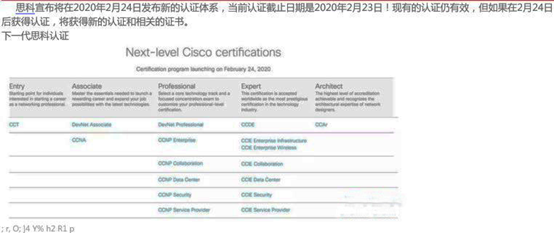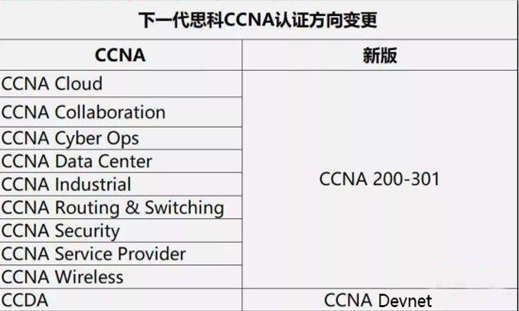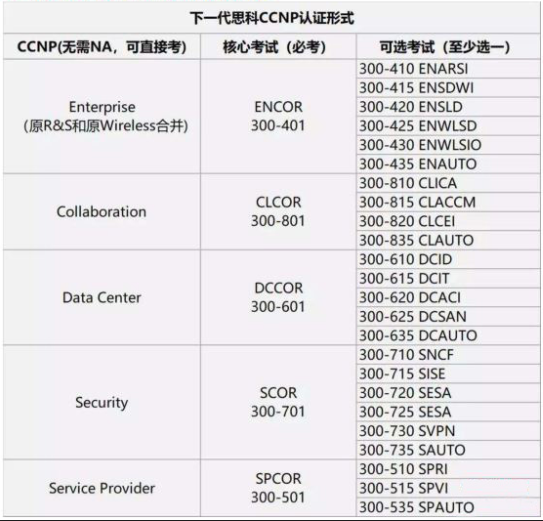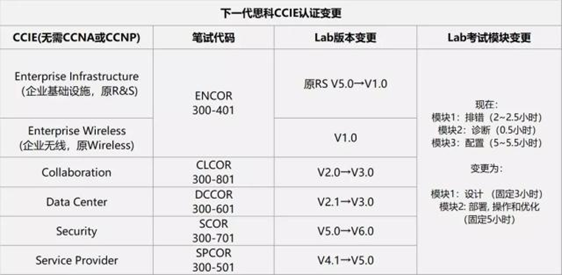【重磅】思科宣布将在2020年2月24日发布新的认证体系!
[ 发表时间:2020-01-05 22:40:24 信息来源:九剑网络 ]
【重磅】思科宣布将在2020年2月24日发布新的认证体系!
思科宣布将在2020年2月24日发布新的认证体系,当前认证截止日期是2020年2月23日!现有的认证仍有效,但如果在2月24日后获得认证,将获得新的认证和相关的证书。所以在学思科认证的小伙伴们,抓紧时间学习考试,新的一波认证来袭后,考题也随之更新。
新一代思科认证

本次思科体系的重大变化
CCNA:
原来的9大方向进行合并,统一只考一门,考试代码200-301

CCNP:
原来的CCNP RS和CCNP Wireless方向合并为CCNP Enterprise方向。考试形式变革,由原先要求3-5门笔试全部通过。而新一代CCNP认证只需要通过2门考试即可,即必考1门核心考试,再加1门可选考试。下一代CCNP可直接考,无需先拥有CCNA认证。

认证形式:

CCIE:
RS将成为过去,改为Enterprise方向,现有的RS认证在新认证发布后自动升级为企业基础设施认证。Design方向改为DevNet方向,CCDA改为DevNet Associate,CCDP改为了DevNet Professional。

Enterprise Infrastructure(原R&S)和 Enterprise Wireless(原Wireless)考相同的IE笔试。NP笔试和IE笔试是同一门,通过NP/IE笔试可以选择直接考取LAB成为CCIE或者是参考一门可选考试成为CCNP。

LAB考试模块由TS+DIAG+Configuration三大模块变更为:设计+部署,操作和优化两大模块。


重认证形式变更为需修满120学分才可激活,类似考NP认证,只需修一门核心考试和一门可选考试即可。新一代CCIE有效期仍为3年,超过3年只需选择重修笔试即可,无需再考LAB。
十年荣誉CCIE变更为二十年荣誉CCIE
在LAB考试中,各个考试内容的框架下图所示:

从思科认证的变化可以看出,新时代对网络工程师的要求将更为系统化和多样化,一专(核心考试)多精(可选考试)成为主流方向,同时每个方向中都有涉及自动化和开发,使原先较为简单的实施交付工程师向更高层次的设计与研发迈进!
关于旧版CCNP RS认证和下一代思科CCNP Enterprise认证混合考的说明:
现有的认证仍有效,但如果改版前未考完,在2月24日后可以继续参加考试,将获得新的认证和相关的证书。简单给大家概括如下:
1 如果已经通过ROUTE (300-101)和SWITCH (300-115),再选考一门下一代思科CCNP的选考科目,可以获得下一代思科CCNP Enterprise认证。
2 如果已经通过TSHOOT (300-135),再考一门下一代思科CCNP核心考试300-401 ENCOR,可以获得下一代思科CCNP Enterprise 认证。
3 如果只通过了一门ROUTE (300-101)或者SWITCH (300-115),考试是无效的,需要重新参加下一代思科CCNP的核心考试和选考科目了。
附考试大纲:
1.Network Infrastructure (30%)
1.1 Switched campus
1.1.a Switch administration
1.1.a i Managing MAC address table
1.1.a ii Errdisable recovery
1.1.a iii L2 MTU
1.1.b Layer 2 protocols
1.1.b i CDP, LLDP
1.1.b ii UDLD
1.1.c VLAN technologies
1.1.c i Access ports
1.1.c ii Trunk ports (802.1q)
1.1.c iii Native VLAN
1.1.c iv Manual pruning
1.1.c v VLAN database
1.1.c vi Normal and extended VLANs
1.1.c vii Voice VLAN
1.1.c viii VTP
1.1.d EtherChannel
1.1.d i LACP, manual
1.1.d ii Layer 2, layer 3
1.1.d iii Load balancing
1.1.d iv EtherChannel misconfiguration guard
1.1.e Spanning-Tree
1.1.e i PVST+, Rapid PVST+, MST
1.1.e ii Switch priority, port priority, path cost, STP timers
1.1.e iii PortFast, BPDU Guard, BPDU Filter
1.1.e iv Loop Guard, Root Guard
1.2 Routing Concepts
1.2.a Administrative distance
1.2.b VRF-lite
1.2.c Static routing
1.2.d Policy-based routing
1.2.e VRF aware routing with any routing protocol
1.2.f Filtering with any routing protocol
1.2.g Manual summarization with any routing protocol
1.2.h Redistribution between any pair of routing protocols
1.2.i Routing protocol authentication
1.2.j Bidirectional Forwarding Detection
1.3 EIGRP
1.3.a Adjacencies
1.3.b Best path selection
1.3.b i RD, FD, FC, successor, feasible successor
1.3.b ii Classic metric and wide metric
1.3.c Operations
1.3.c i General operations
1.3.c ii Topology table
1.3.c iii Packet types
1.3.c iv Stuck In Active
1.3.c v Graceful shutdown
1.3.d EIGRP load-balancing
1.3.d i Equal-cost
1.3.d ii Unequal-cost
1.3.d iii Add-path
1.3.e EIGRP named mode
1.3.f Optimization, convergence and scalability
1.3.f i Fast convergence requirements
1.3.f ii Query propagation boundar
1.4 OSPF (v2 and v3)
1.4.a Adjacencies
1.4.b Network types, area types
1.4.c Path preference
1.4.d Operations
1.4.d i General operations
1.4.d ii Graceful shutdown
1.4.d iii GTSM (Generic TTL Security Mechanism)
1.4.e Optimization, convergence and scalability
1.4.e i Metrics
1.4.e ii LSA throttling, SPF tuning, fast hello
1.4.e iii LSA propagation control (area types)
1.4.e iv Stub router
1.4.e v Loop-free alternate
1.4.e vi Prefix suppression
1.5 BGP
1.5.a IBGP and EBGP peer relationships
1.5.a i Peer-group/update-group, template
1.5.a ii Active, passive
1.5.a iii Timers
1.5.a iv Dynamic neighbors
1.5.a v 4 Bytes AS number
1.5.a vi Private AS
1.5.b Path selection
1.5.b i Attributes
1.5.b ii Best path selection algorithm
1.5.b iii Load-balancing
1.5.c Routing policies
1.5.c i Attribute manipulation
1.5.c ii Conditional advertisement
1.5.c iii Outbound Route Filtering
1.5.c iv Standard and extended communities
1.5.c v Multi-homing
1.5.d AS path manipulations
1.5.d i Local AS, allowas- in, remove private as
1.5.d ii Prepend
1.5.d iii Regexp
1.5.e Convergence and scalability
1.5.e i Route reflector
1.5.e ii Aggregation, AS set
1.5.f Other BGP features
1.5.f i Multipath, add-path
1.5.f ii Soft reconfiguration, route refresh
1.6 Multicast
1.6.a Layer 2 multicast
1.6.a i IGMPv2, IGMPv3
1.6.a ii IGMP Snooping, PIM Snooping
1.6.a iii IGMP Querier
1.6.a iv IGMP Filter
1.6.a v MLD
1.6.b Reverse path forwarding check
1.6.c PIM
1.6.c i Sparse Mode
1.6.c ii Static RP, BSR, AutoRP
1.6.c iii Group to RP Mapping
1.6.c iv Bidirectional PIM
1.6.c v Source-Specific Multicast
1.6.c vi Multicast boundary, RP announcement filter
1.6.c vii PIMv6 Anycast RP
1.6.c viii IPv4 Anycast RP using MSDP
1.6.c ix Multicast multipath
2. Software Defined Infrastructure (25%)
2.1 Cisco SD Access
2.1.a Design a Cisco SD Access solution
2.1.a i Underlay network (ISIS, manual/PnP)
2.1.a ii Overlay fabric design (LISP, VXLAN, Cisco TrustSec)
2.1.a iii Fabric domains (single-site and multi-site)
2.1.b Cisco SD Access deployment
2.1.b i Cisco DNA Center device discovery and device management
2.1.b ii Add edge node devices to an existing fabric
2.1.b iii Host onboarding (wired endpoints only)
2.1.b iv Fabric border handoff
2.1.c Segmentation
2.1.c i Macro-level segmentation using VNs
2.1.c ii Micro-level segmentation using SGTs (using Cisco ISE)
2.1.d Assurance
2.1.d i Network and client health (360)
2.1.d ii Monitoring and troubleshooting
2.2 Cisco SD-WAN
2.2.a Design a Cisco SD-WAN solution
2.2.a i Orchestration plane (vBond, NAT)
2.2.a ii Management plane (vManage)
2.2.a iii Control plane (vSmart, OMP)
2.2.a iv Data plane (vEdge/cEdge)
2.2.b WAN edge deployment
2.2.b i Onboarding new edge routers
2.2.b ii Orchestration with zero-touch provisioning/Plug-And-Play
2.2.b iii OMP
2.2.b iv TLOC
2.2.c Configuration templates
2.2.d Localized policies (only QoS)
2.2.e Centralized policies
2.2.e i Application Aware Routing
2.2.e ii Topologies
3. Transport Technologies and Solutions (15%)
3.1 MPLS
3.1.a Operations
3.1.a i Label stack, LSR, LSP
3.1.a ii LDP
3.1.a iii MPLS ping, MPLS traceroute
3.1.b L3VPN
3.1.b i PE-CE routing
3.1.b ii MP-BGP VPNv4 -v6
3.1.b iii Extranet (route leaking)
3.2 DMVPN
3.2.a Troubleshoot DMVPN phase 3 with dual-hub
3.2.a i NHRP
3.2.a ii IPsec/IKEv2 using preshared key
3.2.a iii Per-Tunnel QoS
3.2.b Identify use-cases for FlexVPN
3.2.b i Site-to-site, Server, Client, Spoke-to-Spoke
3.2.b ii IPsec/IKEv2 using preshared key
3.2.b iii MPLS over FlexVPN
4. Infrastructure Security and Services (15%)
4.1 Device Security on Cisco IOS XE
4.1.a Control plane policing and protection
4.1.b AAA
4.2 Network Security
4.2.a Switch security features
4.2.a i VACL, PACL
4.2.a ii Storm control
4.2.a iii DHCP snooping, DHCP option 82
4.2.a iv IP Source Guard
4.2.a v Dynamic ARP inspection
4.2.a vi Port-security
4.2.a vii Private VLAN
4.2.b Router security features
4.2.b i IPv6 Traffic filters
4.2.b ii IPv4 Access Control Lists
4.2.b iii Unicast Reverse Path Forwarding
4.2.c IPv6 First Hop Security features
4.2.c i RA guard
4.2.c ii DHCP guard
4.2.c iii Binding table
4.2.c iv Device tracking
4.2.c v ND inspection/snooping
4.2.c vi Source guard
4.2.d IEEE 802.1X Port-Based Authentication
4.2.d i Device roles, port states
4.2.d ii Authentication process
4.2.d iii Host modes
4.3 System Management
4.3.a Device management
4.3.a i Console and VTY
4.3.a ii SSH, SCP
4.3.a iii RESTCONF, NETCONF
4.3.b SNMP
4.3.b i v2c
4.3.b ii v3
4.3.c Logging
4.3.c i Local logging, syslog, debugs, conditional debugs
4.3.c ii Timestamps
4.4 Quality of Service
4.4.a End to end L3 QoS using MQC
4.4.a i DiffServ
4.4.a ii CoS and DSCP Mapping
4.4.a iii Classification
4.4.a iv Network Based Application Recognition (NBAR)
4.4.a v Marking using IP Precedence, DSCP, CoS
4.4.a vi Policing, shaping
4.4.a vii Congestion management and avoidance
4.4.a viii HQoS, Sub-rate Ethernet Link
4.5 Network Services
4.5.a First-Hop Redundancy protocols
4.5.a i HSRP, GLBP, VRRP
4.5.a ii Redundancy using IPv6 RS/RA
4.5.b Network Time Protocol
4.5.b i Master, client
4.5.b ii Authentication
4.5.c DHCP on Cisco IOS
4.5.c i Client, server, relay
4.5.c ii Options
4.5.c iii SLAAC/DHCPv6 interaction
4.5.c iv Stateful, stateless DHCPv6
4.5.c v DHCPv6 prefix delegation
4.5.d IPv4 Network Address Translation
4.5.d i Static NAT, PAT
4.5.d ii Dynamic NAT, PAT
4.5.d iii Policy-based NAT, PAT
4.5.d iv VRF aware NAT, PAT
4.5.d v VASI
4.6 Network optimization
4.6.a IP SLA
4.6.a i ICMP probes
4.6.a ii UDP probes
4.6.a iii TCP probes
4.6.b Tracking object
4.6.c Flexible netflow
4.7 Network operations
4.7.a Traffic capture
4.7.a i SPAN
4.7.a ii RSPAN
4.7.a iii ERSPAN
4.7.a iv Embedded packet capture
4.7.b Cisco IOS-XE Troubleshooting tools
4.7.b i Packet-tracer
4.7.b ii Conditional debugger (debug platform condition)
5. Infrastructure Automation and Programmability (15%)
5.1 Data encoding formats
5.1.a JSON
5.1.b XML
5.2 Automation and scripting
5.2.a EEM applets
5.2.b Guest shell
5.2.b i Linux environment
5.2.b ii CLI Python module
5.2.b iii EEM Python module
5.3 Programmability
5.3.a Interaction with vManage API
5.3.a i Python requests library or Postman
5.3.a ii Monitoring endpoints
5.3.a iii Configuration endpoints
5.3.b Interaction with Cisco DNA Center API
5.3.b i HTTP request (GET, PUT, POST) via Python requests library or Postman
5.3.c Interaction with Cisco IOS XE API
5.3.c i Via NETCONF/YANG using Python ncclient library
5.3.c ii Via RESTCONF/YANG using Python requests library or Postman
5.3.d Deploy and verify model-driven telemetry
5.3.d i Configure on-change subscription using gRPC
